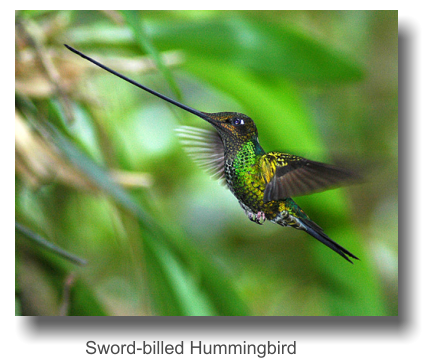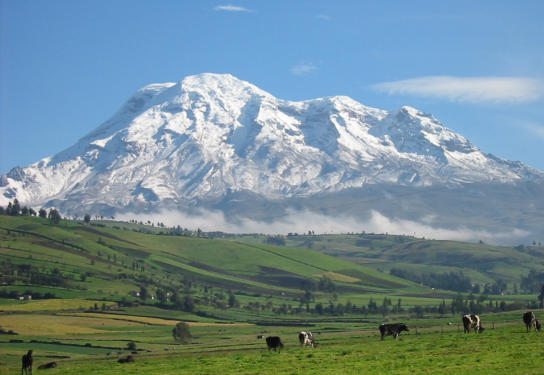


Amazonian Country Located at he heart of the Equatorial Line
Sierra
At the heart of the Andes
The Andes Mountains or Cordillera, in Ecuador is dominated by a range of towering volcanoes and highland valleys, reaching to nearly 18,000 feet (6000 meters). People around the world who had never been in Ecuador, often think that this country is a land of steamy jungles astride the Equatorial Line. The Cordillera is geologically young and volcanic activity still occurs, at present times there are two volcanoes in close proximity that are very active, one of them is Guagua Pichincha a stratovolcano located at only 7 miles (11Km) from Ecuador's capital city of Quito, and the other volcano Tungurahua at only 104 miles (165 km) to the south of Quito and directly above the city of Baños.
This city lies in the heart of Ecuador and is particularly known for
its perpetually mild climate and is a gateway to both the Oriente
and the high peaks of the Andes. Baños is a place with
breathtaking waterfalls, unspoiled green surroundings and
therapeutic hot springs.
The Northern Sierra full of green valleys and dappled with
glistening lakes and crested by volcanic peaks, and the area is
famed for its artisan, centers of native craft work, leather goods
and woodcarving, all within a short bus ride of each other. Of these, Otavalo is undoubtedly the biggest attraction, thanks to its enormous
Saturday market.
The Northern Cordillera is split, with two chains of mountains running parallel from north to south. These valleys bordered by the "Avenue of
the Volcanoes" are a distinct habitat for many of the cities of Ecuador. This area developed flora and fauna adapted to low temperatures,
strong winds, rain, hail, snow and the high altitudes. The Southern Cordillera is a single chain of mountains which are older and lower than the
northern Andes, there are no active volcanoes in this area and the soil has been badly worn with erosion.
The Central Sierra is home to the most spectacular of the country’s volcanoes, including the snowcapped cone of Cotopaxi, and
Chimborazo, Ecuador’s highest peak at 6268m.
Cotopaxi is the second-highest mountain peak in the country, and it is also a beautiful
snow-covered volcano. On clear days it can be seen in all its beauty from Quito.
Cotopaxi is one of South America's most famous volcanoes and one of its most active
ones. With its 5911 m it also ranks among the world's highest active volcanoes.
Chimborazo is Ecuador's highest active volcano and the highest in the Northern
Andean Volcanic Zone, its summit is the farthest point of the earth's surface from the
center of the earth. The distance of Chimborazo's summit from the center is 6,384.4
km, 2229 m more than the distance of Mt Everest's top to the center. (Source:
Wikipedia).
Five million years ago, at the beginning of the Pliocene period, the Andes started to
form. The mountain range divides the country in three sections; one low forested
plain at each side of the Eastern and Western Cordilleras and in the middle of the
interandean ranges a narrow band of basins and valleys. These valleys are semi-arid
ecosystems with eucalyptus and pine trees.
The rainy season in this area lasts from October to May, with an annual temperature range of 53° to 64°F (12° to 18°C). A lush forest is found
along the outer flanks of the Andes Mountains, between 8,400 and 9,900 feet (2800 and 3300 meters) of altitude. This ecosystem exists
because of the clouds that bathe the sides of the Andes range. As the clouds are forced up to greater altitude, the air grows cooler. Since cool
air holds less moisture than warm air, most of the moisture in the clouds is dropped along the flanks as mist or precipitation, resulting in the
lush cloud forest ecosystem. This phenomenon is known as the "Rain Shadow Effect". The air that passes over the mountains and into the
valleys is dry, resulting in an arid habitat for this zone.
The Andean Páramo is found at altitudes of 11,500 - 14,750 feet (3600 - 4800 meters), ecosystem characterized by low precipitation, high
winds and low temperatures. The Andean Páramos are covered with gramineous plants, creepers, spongy herbs, páramo grasses and rose-
like flowers. One tenth (9,652sq. Miles) of the Ecuadorian land is covered with Páramos, this is a habitat ideal for condors, caracaras, deer,
llamas, tapir, vicuñas, multicolored flowers and the most beautiful hummingbirds.
This is a rigorous habitat and the organisms that have evolved here have by necessity, adapted to living under relatively harsh conditions. For
example, plants in the páramo are pollinated by wind, hummingbirds, or beetles because the winds are too strong and constant for flying
insects to carry out the job that they do elsewhere.

©1996 el-ecuador.com - All rights reserved. - This Web site was created and maintained by: Fernando Silva
This site was last updated on: March 16, 2025







Your Company Here
Advertise with us and
expose your company
worldwide..
Anuncie con nosotros y
exponga su compañía
ante todo el mundo.
Contact us

Your Company Here
Advertise with us and
expose your company
worldwide..
Anuncie con nosotros y
exponga su compañía
ante todo el mundo.
Contact us





















